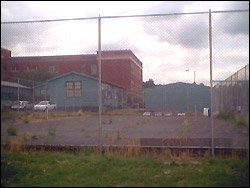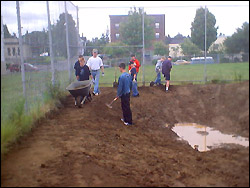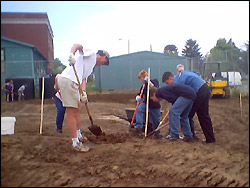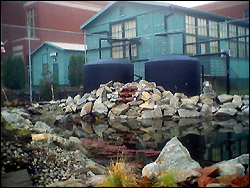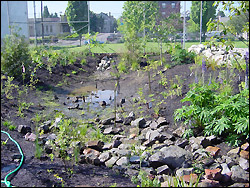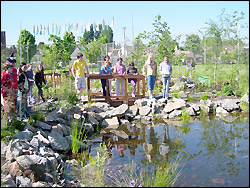 |
||||||||||||||||
| da
Vinci Arts Middle School Jean Vollum Natural Capital Center (Ecotrust Building) People's Food Coop ShoreBank Pacific |
Evans initiated the project as a way to directly involve his students in urban ecology – and involved they have been – from design, to construction, to maintenance.
The old tennis court area is more than just a garden though. The area is a fairly sophisticated stormwater management site that captures and processes stormwater runoff from a large parking area as well as the roofs of 4 large portable buildings positioned next to the school.
The project includes the following elements. Two 5000 gallon cisterns receive runoff from two of the portable buildings. A small wet pond receives water from the other two portable buildings and includes a pump that recirculates water through a series of sculptural flow forms that illustrate water’s natural movement, and help oxygenate the pond. The pond which was dug and shaped by students and volunteers is lined with native plants. When water levels rise to a certain point, it flows through an outlet into a small gravel lined streambed that carries the water to a small wetland area.
A $30,000 City of Portland Bureau of Environmental Services stewardship grant, and a number of other grants helped with project costs, but the majority of the work was done with volunteer labor and donated or significantly discounted materials. A local group, Urban Water Works worked extensively with school, and Evans says that he and many students spent their summer working on the project. Evans’ estimates that the stormwater garden will remove between 300,000 and 500,000 gallons of water a year from the City of Portland’s sewer system. Equally as important, he envisions the area as a living laboratory and art space for future students. Currently, student construction continues on a shelter area and artistic flags hang from the still intact chain link fence that once surrounded the tennis court.
When asked what was next, Evans’ replied, “a living machine, run by solar and wind power that can treat all of the liquid waste generated by our school cafeteria” and he was off again jumping into the details of the next project.
|
|||||||||||||||
